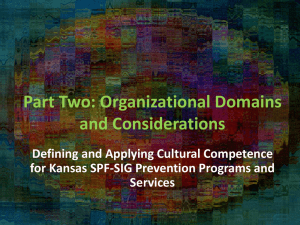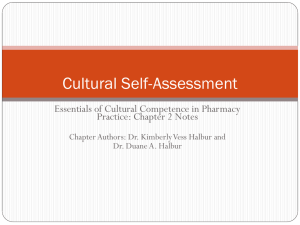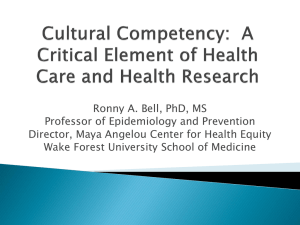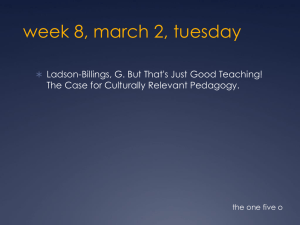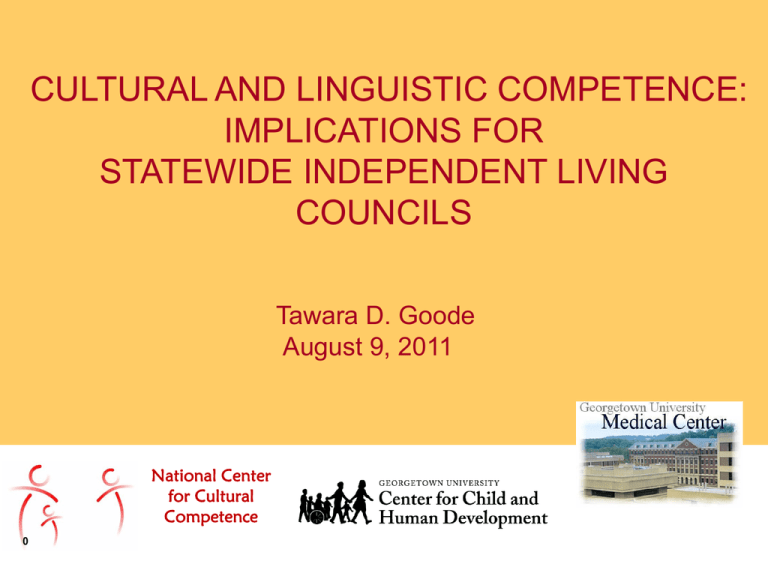
CULTURAL AND LINGUISTIC COMPETENCE:
IMPLICATIONS FOR
STATEWIDE INDEPENDENT LIVING
COUNCILS
Tawara D. Goode
August 9, 2011
National Center
for Cultural
Competence
0
CULTURAL AND LINGUISTIC COMPETENCE:
IMPLICATIONS FOR
STATEWIDE INDEPENDENT LIVING
COUNCILS
Tawara D. Goode
August 9, 2011
National Center
for Cultural
Competence
1
Rationale for Cultural and Linguistic Competence
in Independent Living
Demographic changes in the U.S., its
territories, and tribal communities
Diversity of world views and beliefs about
disability
Laws & Federal and State Mandates
Improve quality, effectiveness, and satisfaction
with services and supports
Address racial, ethnic, socio-economic, and
geographic disparities
2
Slide Source:© 2011 - National Center for Cultural Competence
Why should SILCs address cultural and linguistic
competence?
Access
Effectiveness
Acceptability
Satisfaction
IMPROVEMENT
Services
Supports
Outcomes
3
Slide Source:© 2011 - National Center for Cultural Competence
Culture
is the learned and shared knowledge that
specific groups use to generate their behavior and
interpret their experience of the world. It includes but is
not limited to:
roles
communication
values
rituals
relationships
thought
courtesies
beliefs
customs
languages
manners of
interacting
practices
expected
behaviors
Culture applies to racial, ethnic, religious, political, professional, and other social
groups. It is transmitted through social and institutional traditions and norms to
succeeding generations. Culture is a paradox, while many aspects remain the same,
it is also dynamic, constantly changing.
Slide Source:© 2011 - National Center for Cultural Competence
Data Source: Gilbert, J. Goode, T., & Dunne, C., 2007.
4
Cultural Diversity
The term cultural diversity is used to
describe differences in ethnic or racial
classification & self-identification, tribal
or clan affiliation, nationality, language,
age, gender, sexual orientation, gender
identity or expression, socioeconomic
status, education, religion, spirituality,
physical and intellectual abilities,
personal appearance, and other factors
that distinguish one group or individual
from another.
Goode & Jackson, 2009
5
Slide Source: © 2011 - National Center for Cultural Competence
Multiple Cultural Identities
I
M
P
O
R
T
A
N
C
E
POINT IN TIME & CONTEXT
6
Slide Source: 2011 - National Center for Cultural Competence
VIEWS ON DISABILITY IDENTITY
The population of people who
experience disability is extraordinarily
diverse and, therefore, the idea of a
common disability identity isolates
disability artificially from intersecting
identities related to race, gender, sexuality,
class, age, and other axes of social significance.
(p.43).
SOURCE: Gill, C. & Cross, W. (2010). Disability Identity and Racial-Cultural Identity Development: Points of Convergence,
Divergence and Interplay. In F. Balcazar, Y. Suarez-Balcazar, T. Taylor-Ritzler, & C. Keys (Eds.), Race, Culture, and Disability:
Rehabilitation Science and Practice. Sudbury, MA: Jones and Bartlett Publishers
7
Slide Source: 2011 - National Center for Cultural Competence
RACIAL IDENTITY vs. DISABILITY IDENTITY
S ABOUT DISABILITY IDENTITY
There is no simple relationship between
race and disability.
Some people of color with disabilities have
prioritized their identification and affiliation
with persons who share their cultural/racial
heritage and have had little contact with
disability groups.
They tend to see disability in terms of
limitation rather than identity.(p.46)
SOURCE: Gill, C. & Cross, W. (2010). Disability Identity and Racial-Cultural Identity Development: Points of Convergence,
Divergence and Interplay. In F. Balcazar, Y. Suarez-Balcazar, T. Taylor-Ritzler, & C. Keys (Eds.), Race, Culture, and Disability:
Rehabilitation Science and Practice. Sudbury, MA: Jones and Bartlett Publishers
8
Slide Source: 2011 - National Center for Cultural Competence
RACIAL IDENTITY vs. DISABILITY IDENTITY
Some people of color have substantial
contact with disability groups.
They are more likely to identify as being
“disabled” and to reference parallels
between race and disability.
Some say that their experiences of
race-based oppression have prepared
them to understand disability as a social
minority experience. This suggests intersectional
expressions of identify. (p.46)
SOURCE: Gill, C. & Cross, W. (2010). Disability Identity and Racial-Cultural Identity Development: Points of Convergence,
Divergence and Interplay. In F. Balcazar, Y. Suarez-Balcazar, T. Taylor-Ritzler, & C. Keys (Eds.), Race, Culture, and Disability:
Rehabilitation Science and Practice. Sudbury, MA: Jones and Bartlett Publishers
9
Slide Source: 2011 - National Center for Cultural Competence
Cultural Competence
Definition & Framework
10
Are we on the same page?
Culturally
aware
Culturally
competent
Cultural
humility
Culturally
relevant
Cultural
sensitivity
Culturally & linguistically competent
Multicultural Competence
Linguistically
competent
11
T.D. Goode
Culturally appropriate
Culturally
effective
Cultural
Proficiency
Slide Source:© 2011 - National Center for Cultural Competence
Cultural Competence
behaviors
practices
attitudes
policies
structures
requires that organizations have a clearly defined,
congruent set of values and principles, and demonstrate
behaviors, attitudes, policies, structures, and practices
that enable them to work effectively cross-culturally
(adapted from from Cross, Bazron, Dennis and Isaacs, 1989)
12
Slide Source:© 2011 - National Center for Cultural Competence
Five Elements of Cultural Competence
Organizational Level
value diversity
conduct cultural self-assessment
manage the dynamics of difference
institutionalize cultural knowledge
adapt to diversity
- policies - structures
- values - services
(Cross, Bazron, Dennis and Isaacs, 1989)
13
Slide Source:© 2011 - National Center for Cultural Competence
Five Elements of Cultural Competence
Individual Level
acknowledge cultural differences
understand your own culture
engage in self-assessment
acquire cultural knowledge & skills
view behavior within a cultural context
(Cross, Bazron, Dennis and Isaacs, 1989)
14
Slide Source:© 2011 - National Center for Cultural Competence
ESSENTIAL ELEMENTS IN A
CULTURALLY COMPETENT SYSTEM
These five elements must be manifested at every level of
an organization including:
policy makers
administration
practice & service delivery
consumer/patient/family
community
and reflected in its attitudes, structures, policies, practices,
and services.
Adapted from Cross, Bazron, Dennis, & Isaacs, 1989
15
Slide Source:© 2011 - National Center for Cultural Competence
Cultural Competence Continuum
(Cross, Bazron, Dennis and Isaacs, 1989)
Cultural
Proficiency
Cultural
Competence
Cultural
Pre-Competence
Cultural
Blindness
Cultural
Incapacity
Cultural
Destructiveness
16
Slide Source:© 2011 - National Center for Cultural Competence
Linguistic Competence
Definition & Framework
17
Languages Other Than English Spoken at Home in the U.S.
Total Population 5 years and over
285,797,349*
Speak Spanish or Spanish Creole
35,468,501
Speak Indo European languages
10,495,295
[French (Patois, Cajun), French Creole, Italian, Portuguese, Portuguese Creole, German, Yiddish, Other West Germanic
languages, Scandinavian languages, Greek, Russian, Polish, Serbo-Croatian, Other Slavic languages, Armenian, Persian,
Gujarathi, Hindi, Urdu, Other Indic languages]
Speak Asian and Pacific Island languages
8,698,825
[Chinese, Japanese, Korean, Mon-Kymer, Cambodian, Miao, Hmong, Thai, Laotian, Vietnamese, Tagalog, other
Pacific Island languages]
Other Languages
2,435,383
[Navajo, Other Native American languages, Hungarian, Arabic, Hebrew, African languages, other unspecified languages]
* Total estimated U.S. population including those who speak English
18
Data Source:
S1601. Languages Spoken at Home, 2009 American
Community Survey Year 1 Estimates, U.S. Census Bureau
Slide Source: National Center for Cultural Competence, 2011
What is Linguistic Isolation?
Linguistic isolation refers to households in which no person
over the age of 14 speaks English at least very well
Linguistically Isolated Households in the U.S. in 2009
All households
4.7%
Households speaking--
Spanish
Other Indo-European languages
Asian and Pacific Island languages
Other languages
19
Data Source:
U.S. Census Bureau
2009 American Community Survey – 1 Year Estimates
25.9%
16.6%
27.5%
17.2%
Slide Source: National Center for Cultural Competence, 2011
LINGUISTIC COMPETENCE FRAMEWORK
POLICY
DEDICATED
FISCAL
RESOURCES
PRACTICES
LINGUISTIC
COMPETENCE
DEDICATED
PERSONNEL
RESOURCES
STRUCTURES
PROCEDURES
Goode & Jones, Revised 2009, National Center for Cultural Competence
20
Slide Source:© 2011 - National Center for Cultural Competence
Linguistic Competence:
Legal Mandates, Guidance, and Standards
21
Linguistic Competence:
Legal Mandates, Regulations, Guidance, and Standards
Title VI of the Civil Rights Act of 1964,
Section 601 Non-Discrimination in
Federally-Assisted Programs
National Standards on Culturally
and Linguistically Appropriate Services
(CLAS)
22
Slide Source: National Center for Cultural Competence, 2011
Title VI - Civil Rights Act of 1964
SEC. 601 TITLE VI--NONDISCRIMINATION IN FEDERALLY ASSISTED PROGRAMS
Provisions related to language access:
Service providers should implement policies
and procedures to provide access to services
and information in appropriate languages other
than English to ensure that persons with limited
English proficiency are effectively informed and
effectively participate in any benefit.
http://usinfo.state.gov/usa/infousa/laws/majorlaw/civilr19.htm
23
Data Source: Civil Rights Act of 1964, P.L. 88-62
Slide Source: National Center for Cultural Competence, 2011
Linguistic Competence:
Legal Mandates, Regulations, Guidance, and Standards
Non- Discrimination based on Race, Color, National Origin, Age, Disability, Sex
Title IX, Education
Amendments of
1972
Rehabilitation Act
of 1973,
Section 504
Title VI, Section
601, Civil
Rights Act of
1964
Age Discrimination
Act of 1975
Title II, Americans
with Disabilities
Act of 1990
24
Slide Source: National Center for Cultural Competence, 2011
Linguistic Competence:
The Roles of Health and Mental Health Literacy
25
Definition of Health Literacy
The degree to which individuals have
the capacity to obtain, process, and
understand basic health information
and services needed to make
appropriate health decisions.
HP 2010: Health
Communicationhttp://www.hrsa.gov/quality/healthlit.htm
DATA SOURCE: National Libraries of Medicine, 2000
26
Slide Source: National Center for Cultural Competence, 2011
Definition of Mental Health Literacy
“Mental health literacy is the
knowledge, beliefs, and
abilities that enable the
recognition, management, or
prevention of mental health
problems.”
27
Data Source: Canadian Alliance on Mental Illness and Mental Health
Slide Source: National Center for Cultural Competence, 2011
Characteristics of Culturally & Linguistically
Competent Organizations
28
Characteristics of Culturally &
Linguistically Competent Organizations
philosophy
mission statement
policy, structures, procedures, practices
diverse, knowledgeable & skilled workforce
dedicated resources & incentives
community engagement & partnerships
publish & disseminate
advocacy
29
Slide Source:© 2011 - National Center for Cultural Competence
CLC: What are the implications for SILCs
INDEPENDENT LIVING SERVICES
acquire knowledge of cultural beliefs and practices
about the concept of “independent”
identify best and evidence-based practices on
increasing and enhancing independent living
services within culturally and linguistically diverse
communities
ensure that the state plan addresses the role of
cultural and linguistic competence in independent
living (i.e. philosophy, policy, and practice, evaluation)
30
Slide Source:© 2011 - National Center for Cultural Competence
CLC: What are the implications for SILCs
DATA GATHERING & ANALYSIS
TO INFORM PUBLIC POLICY
ensure the collection of racial, ethnic, and primary
language data for all independent living services
identify the nature and scope of disparities (i.e. race,
ethnicity, gender, primary language, geographic
locale)
develop reports that include policy implications of
addressing disparities within the state
conduct studies on preferences, needs, and
satisfaction with independent living services for
culturally and linguistically diverse groups
31
Slide Source:© 2011 - National Center for Cultural Competence
CLC: What are the implications for SILCs
ENGAGING COMMUNITIES IN SPIL
DEVELOPMENT & EVALUATION
ensure that community engagement activities
incorporate cultural beliefs and practices
ensure that community engagement activities are
conducted in a culturally and linguistically
competent manner, including but not limited to:
- provision of language access services (interpretation and
translation)
- scheduling avoids cultural, religious, spiritual observances
- racial, ethnic, language and gender concordance (when
requested)
32
Slide Source:© 2011 - National Center for Cultural Competence
CLC: What are the implications for SILCs
ENGAGING COMMUNITIES IN SPIL
DEVELOPMENT & EVALUATION
(cont’d)
ensure that community engagement activities are
conducted in a culturally and linguistically
competent manner, including but not limited to:
- recognizes and acknowledges culturally-defined approaches
to advocacy
- convene at times and settings in keeping with individual and
community norms
- evaluation includes the extent to which culture and language
are addressed
33
Slide Source:© 2011 - National Center for Cultural Competence
CLC: What are the implications for SILCs
ENGAGING COMMUNITIES IN SPIL
DEVELOPMENT & EVALUATION
conduct information dissemination and public awareness
efforts about the SPIL within diverse communities including:
– urban, suburban, frontier
– tribal communities
– U.S. territories
ensure information dissemination in languages other than
English
collaborate with cultural brokers and key community
informants to conduct community engagement activities
provide guidance on developing policy and practices that
support culturally and linguistically competent community
outreach and engagement
34
Slide Source:© 2011 - National Center for Cultural Competence
CLC: What are the implications for SILCs
STATE PLAN
Do goals, objectives, and/or strategies include a focus on:
- needs and preferences of underserved or inappropriately served
racial and ethnic groups?
- disparities by race, ethnicity, primary language, gender, geographic
locale?
- cultural and linguistic competence in the planning, delivering, and
evaluating independent living services?
- outreach and engaging diverse communities?
Does the budget allocate fiscal resources to address the needs
and preferences of culturally and linguistically diverse
populations?
Do strategies address compliance with Title VI, Section 601,
Non-Discrimination in Federally-Assisted Programs?
35
Slide Source:© 2011 - National Center for Cultural Competence
CLC: What are the implications for SILCs
STATE PLAN
Does the plan:
report services provided in the state by race, ethnicity, primary
language?
describe the capacity of the network of CILs to provide culturally and
linguistically competent services?
describe how providers in the state’s independent living network
collaborate to address disparities (i.e. race, ethnicity, primary
language, geographic locale)? enhance cultural and linguistic
competence?
include evaluation criteria that assesses cultural and linguistic
competence?
specify budget line items to support state efforts to address
underserved communities?
36
Slide Source:© 2011 - National Center for Cultural Competence
Applying the Principles and Practices of Cultural and
Linguistic Competence to How the SILCs do their Work
Ensure that the SILC membership is
reflective of the cultural and
linguistic diversity within the state. Attend
to gaps in representation when recruiting
new SILC members.
Provide training to all members on the
SILC's philosophy, policy, and practices
on ensuring cultural and linguistic
competence.
37
Slide Source:© 2011 - National Center for Cultural Competence
Applying the Principles and Practices of Cultural and
Linguistic Competence to How the SILCs do their Work,
cont’d.
Ensure the provision of interpretation
and translation services to members
who prefer and need language
assistance.
Recognize and respond to cultural
differences in conducting meetings,
group decision-making, and information
sharing in Council activities.
38
Slide Source:© 2011 - National Center for Cultural Competence
Cultural competence
and linguistic competence
are a life’s journey …
not a destination
Safe travels!
39
T.D. Goode
Slide Source: National Center for Cultural Competence, 2011
National Center for Cultural Competence
The content of and this PowerPoint presentation are copyrighted and are
protected by Georgetown University's copyright policies.
Permission is required to use or modify this PowerPoint presentation:
in its entirety, individual slides, or excerpts.
for broad or multiple dissemination.
for commercial purposes.
To request permission and for more information, contact
cultural@georgetown.edu.
Please visit our website at http://nccc.georgetown.edu
40
Slide Source:© 2011 - National Center for Cultural Competence
Wrap Up and Evaluation
Please complete the evaluation of this
program by clicking here:
https://vovici.com/wsb.dll/s/12291g4bb34
41
SILC-NET Attribution
This webinar/teleconference was presented by the SILCNET, a project of the IL NET, an ILRU/NCIL/APRIL
National Training and Technical Assistance Program.
Support for this presentation was provided by the U.S.
Department of Education, Rehabilitation Services
Administration under grant number H132B070003-10.
No official endorsement of the Department of Education
should be inferred
42





